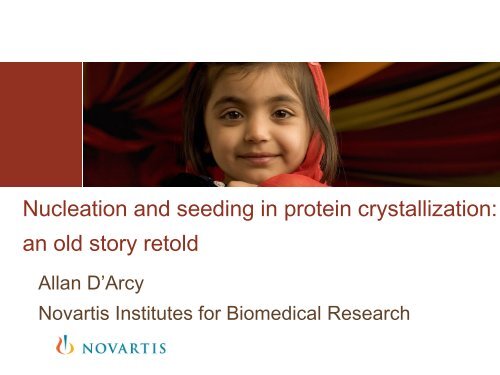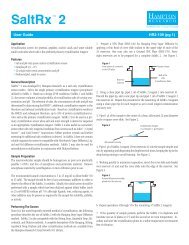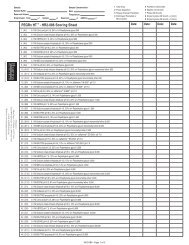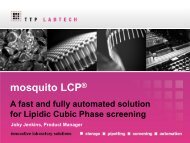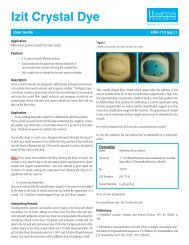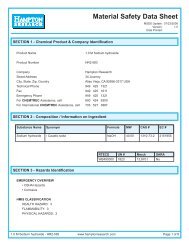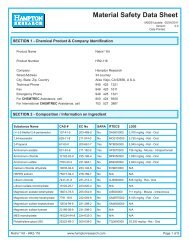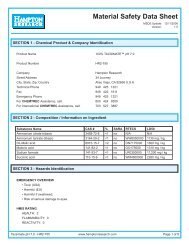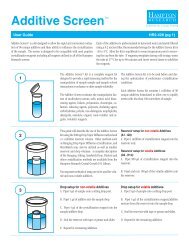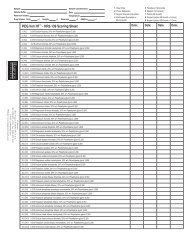Nucleation and seeding in protein crystallization - Hampton Research
Nucleation and seeding in protein crystallization - Hampton Research
Nucleation and seeding in protein crystallization - Hampton Research
- No tags were found...
Create successful ePaper yourself
Turn your PDF publications into a flip-book with our unique Google optimized e-Paper software.
<strong>Nucleation</strong> <strong>and</strong> <strong>seed<strong>in</strong>g</strong> <strong>in</strong> prote<strong>in</strong> <strong>crystallization</strong>:<br />
an old story retold<br />
Allan D’Arcy<br />
Novartis Institutes for Biomedical <strong>Research</strong>
The Crystallization flowchart<br />
Purification <strong>and</strong><br />
pre-screen<strong>in</strong>g<br />
Screen<strong>in</strong>g<br />
Gels, SEC, DLS, MS, NMR<br />
<strong>Nucleation</strong> <strong>and</strong> <strong>seed<strong>in</strong>g</strong><br />
Observation<br />
Real hits <strong>and</strong> false positives<br />
Optimisation<br />
<strong>Nucleation</strong> <strong>and</strong> <strong>seed<strong>in</strong>g</strong>
Grow<strong>in</strong>g prote<strong>in</strong> crystals<br />
We have 2 basic questions to answer:<br />
1. Is the prote<strong>in</strong> crystallizable<br />
2. How good are the crystals
Good or bad prote<strong>in</strong><br />
Impurities<br />
Aggregation Flexible doma<strong>in</strong>s Flexible tail<br />
Proteolysis<br />
Unfold<strong>in</strong>g „Pure“ prote<strong>in</strong> Crystals<br />
4 | Presentation Title | Presenter Name | Date | Subject | Bus<strong>in</strong>ess Use Only
Classes of prote<strong>in</strong>s<br />
(an oversimplified view!)<br />
Prote<strong>in</strong>s that cannot crystallize<br />
Aggregation/wrongly folded<br />
Prote<strong>in</strong>s that are easy to crystallize<br />
Prote<strong>in</strong>s that are perfect but difficult to crystallize
Why don’t they crystallize readily<br />
• ~ 30% of “well behaved prote<strong>in</strong>s don’t crystallize”<br />
Glycosilation Flexible term<strong>in</strong>i/doma<strong>in</strong>s Too soluble<br />
<strong>Nucleation</strong> <strong>and</strong> <strong>seed<strong>in</strong>g</strong> | Allan D’Arcy | September 2007 RAMC
Prote<strong>in</strong> very soluble, no nucleation<br />
[Prote<strong>in</strong>]<br />
without <strong>seed<strong>in</strong>g</strong><br />
[Precipitant]
<strong>Nucleation</strong> <strong>and</strong> <strong>seed<strong>in</strong>g</strong> <strong>in</strong> prote<strong>in</strong><br />
<strong>crystallization</strong><br />
<strong>Nucleation</strong> <strong>in</strong> general<br />
Seed<strong>in</strong>g methods<br />
Matrix <strong>seed<strong>in</strong>g</strong>, method <strong>and</strong> results
<strong>Nucleation</strong><br />
• The growth of prote<strong>in</strong> crystals requires 2 sequential<br />
processes <strong>and</strong> optimum conditions for these processes<br />
differ<br />
• <strong>Nucleation</strong> (high concentrations of prote<strong>in</strong> <strong>and</strong>/or precipitant)<br />
• 3D growth (lower concentrations of prote<strong>in</strong> <strong>and</strong>/or precipitant)<br />
• In screens there are often too many clear drops because<br />
spontaneous nucleation cannot occur<br />
• Have we neglected the nucleation event
What effects nucleation<br />
Sample concentration(1-100mg/ml)<br />
Sample preparation (filter<strong>in</strong>g,mix<strong>in</strong>g etc.)<br />
Method used, VD, MB, FID<br />
Surfaces<br />
10
Drop set up (mix)<br />
Mix<strong>in</strong>g drops
Filter<strong>in</strong>g sample to reduce nucleation<br />
Gooey mess too many crystals<br />
Reduced nucleation 2.0 A diffraction
Drop size<br />
• D. G. Georgieva, M. E. Kuil, T. H. Oosterkamp, H. W. Z<strong>and</strong>bergen <strong>and</strong> J. P.<br />
Abrahams et al. Acta Cryst. (2007). D63, 564-570<br />
Nano<strong>crystallization</strong> is not a simple m<strong>in</strong>iaturization of a prote<strong>in</strong>-<strong>crystallization</strong><br />
experiment <strong>and</strong> that one cannot reduce the <strong>crystallization</strong> volume<br />
without pay<strong>in</strong>g a penalty. In nanovolumes, surface-tension forces become<br />
more prom<strong>in</strong>ent <strong>and</strong> might have effects on the nucleation event. Furthermore,<br />
Bodenstaff et al. (2002) showed that the mean number of nuclei formed per unit<br />
volume is l<strong>in</strong>early proportional to the volume of the mother liquor. Moreover, when<br />
work<strong>in</strong>g <strong>in</strong> a nanolitre regime, the time before the first nuclei are<br />
formed <strong>in</strong>creases dramatically.
The effect of <strong>in</strong>creas<strong>in</strong>g drop size<br />
100nl +100nl 300nl +300nl 2ul +2ul<br />
3 10<br />
~60<br />
8 25<br />
~70
Different <strong>seed<strong>in</strong>g</strong> methods
Different <strong>seed<strong>in</strong>g</strong> methods: Streak<br />
Streak <strong>seed<strong>in</strong>g</strong> with<br />
needle or hair
Different <strong>seed<strong>in</strong>g</strong> methods: Seed bead<br />
Seed bead no dilution<br />
Seed bead 1:10 dilution<br />
Seed bead 1:100 dilution<br />
Seed bead 1:1000 dilution
Different <strong>seed<strong>in</strong>g</strong> methods: Macro<br />
Crystal displacement
Different <strong>seed<strong>in</strong>g</strong> methods: Heterogeneous
Crystals of chicken triose phosphate<br />
ismoerase, the first TIM barrel 1970<br />
• Courtesy of Dave Banner (Roche)
The first artifial snow crystals<br />
• 1954 – Ukichiro Nakaya<br />
• Nakaya's real triumph, came<br />
from grow<strong>in</strong>g artificial snow<br />
crystals <strong>in</strong> the laboratory under<br />
controlled conditions.<br />
• This success was apparently<br />
due to rabbit hairs fall<strong>in</strong>g from<br />
his parka hood <strong>in</strong>to the<br />
experiment!!!
Hair as a successful nucleant<br />
Acta Cryst. (2007). D63, 564-570<br />
Heterogeneous nucleation of three-dimensional prote<strong>in</strong> nanocrystals<br />
D. G. Georgieva, M. E. Kuil, T. H. Oosterkamp, H. W. Z<strong>and</strong>bergen <strong>and</strong> J. P.<br />
Abrahams
Cause <strong>and</strong> effect/proof of concept<br />
• Horse hair is responsible for nucleation<br />
Control: no hair added<br />
Concentrated hair added<br />
Diluted hair added
Hair is visible with<strong>in</strong> crystal
Other nucleation agents<br />
• McPherson <strong>and</strong> Schlichta 1987: Crushed m<strong>in</strong>eral materials<br />
• Punzi et al.1991: Polyv<strong>in</strong>ylidene Difluoride<br />
• Chayen et al. 2001: Porous silica<br />
• Rong et al. 2004: Porous silica<br />
• Pechkova et al. 2001: 2002 Langmuir–Blodgett technique<br />
• Fermani et al. 2001: Polymeric films.<br />
• Haushalter <strong>and</strong> McPherson 2002: Nanoeng<strong>in</strong>eered<br />
Surfaces<br />
• Molecularly impr<strong>in</strong>ted polymers 2011 Saridakis
A major breakthrough<br />
“Microseed Matrix Seed<strong>in</strong>g
Important publication<br />
Acta Cryst. (2004). D60, 601-605<br />
Microseed matrix screen<strong>in</strong>g to improve crystals of yeast cytos<strong>in</strong>e<br />
deam<strong>in</strong>ase<br />
G. C. Ireton <strong>and</strong> B. L. Stoddard<br />
A <strong>crystallization</strong> strategy termed `microseed matrix<br />
screen<strong>in</strong>g.<br />
This method is an extension of conventional <strong>seed<strong>in</strong>g</strong><br />
techniques <strong>in</strong> which microseeds from the nucleation step<br />
are systematically seeded <strong>in</strong>to new conditions where all<br />
components of the drop are allowed to vary to screen for<br />
subsequent growth of well ordered specimens.
Separat<strong>in</strong>g nucleation <strong>and</strong> growth<br />
(~28% PEG 8000, 0.1 M<br />
sodium cacodylate pH 6.5)<br />
25% PEG 8000, 0.1 M<br />
calcium acetate, 0.1 M<br />
sodium cacodylate pH 6.5<br />
- Ca + Ca<br />
All attempts to grow the new crystal form under these<br />
conditions by de novo nucleation<br />
(without transfer of microseeds) were<br />
unsuccessful.<br />
28
Microseed Matrix Seed<strong>in</strong>g:<br />
preparation of seeds<br />
• Seed stock preparation:<br />
• Select best crystals possible<br />
• Crush crystals <strong>in</strong> their reservoir solution us<strong>in</strong>g <strong>Hampton</strong> tools<br />
• Transfer to <strong>Hampton</strong> seed bead <strong>and</strong> vortex for at least 3 m<strong>in</strong>utes or place on<br />
Thermoshaker 10“ on 2“ off for 10-30 m<strong>in</strong>s<br />
• Store at -80°C
Matrix Seed<strong>in</strong>g: Automated <strong>seed<strong>in</strong>g</strong><br />
• Screen Setup<br />
• Use Oryx robot with <strong>seed<strong>in</strong>g</strong> function<br />
• Dispensed drops 0.6µl drops conta<strong>in</strong><strong>in</strong>g<br />
0.3µl prote<strong>in</strong><br />
0.2µl reservoir solution<br />
0.1µl seed stock
Screen<strong>in</strong>g for <strong>in</strong>itial <strong>crystallization</strong> conditions<br />
• ~ 300 “precipitat<strong>in</strong>g agents are tested <strong>in</strong> the first screens<br />
• 300nl of prote<strong>in</strong> are mixed with 300nl of precipitat<strong>in</strong>g agent
Th<strong>in</strong>gs you see <strong>in</strong> drops (some could be used as seeds)<br />
Bushels Spherulites Phase separation<br />
Precipitate <strong>and</strong> xtals Sea urch<strong>in</strong>s Sk<strong>in</strong>s<br />
http://xray.bmc.uu.se/terese/<strong>crystallization</strong>/tutorials/tutorial2.html
Microcrystall<strong>in</strong>e droplets/phase separation<br />
Seed anyth<strong>in</strong>g that might be<br />
crystall<strong>in</strong>e”<br />
(Terese Bergfors)
St<strong>and</strong>ard <strong>seed<strong>in</strong>g</strong> <strong>and</strong> MMS<br />
Normal <strong>seed<strong>in</strong>g</strong>, <strong>in</strong>to same conditions at lower concentrations<br />
Matrix <strong>seed<strong>in</strong>g</strong>,<strong>in</strong>to many new conditions at different concentrations<br />
1 2 3 4 5 6 7 8 9 10 11 12<br />
A 0 0 0 0 0 0 0 0 0 0 0 0<br />
B 0 0 0 0 6 0 0 0 0 0 0 0<br />
C 0 0 6 0 0 0 0 0 0 0 0 0<br />
D 0 0 0 0 0 0 0 0 0 0 0 0<br />
New screen<br />
E 0 0 0 0 0 0 0 0 0 0 0 0<br />
F 0 0 0 0 0 0 0 0 0 0 0 0<br />
G 0 0 0 0 0 0 0 0 0 0 0 0<br />
H 0 0 0 0 0 0 0 0 0 0 0 0
You may generate more false positives..<br />
A lot of time <strong>and</strong> effort can be wasted, test<strong>in</strong>g or<br />
optimiz<strong>in</strong>g conditions that turn out to be salt crystals<br />
Recogniz<strong>in</strong>g false positives
Recogniz<strong>in</strong>g typical morphologies
Us<strong>in</strong>g UV to identify prote<strong>in</strong> crystals<br />
Filter 1Transmission from 260 – 395 nm<br />
Filter 2Transmission from 270 - 320 nm
Salt crystals
Example of confirmed screen hit
Automated microseed matrix <strong>seed<strong>in</strong>g</strong><br />
Results <strong>and</strong> observations
CYS protease<br />
• Start<strong>in</strong>g crystals us<strong>in</strong>g published conditions<br />
•3 hits without <strong>seed<strong>in</strong>g</strong><br />
•53 hits with <strong>seed<strong>in</strong>g</strong><br />
Result:<br />
More hits better morphology
Viral prote<strong>in</strong><br />
Orig<strong>in</strong>al hit <strong>in</strong> Peg screen<br />
1 hit without seeds<br />
64 hits with seeds<br />
Result:<br />
More hits better morphology led<br />
to first <strong>in</strong>hibitor complex
Metallo Protease<br />
Only one crystal grew spontaneously<br />
<strong>in</strong> published conditions<br />
•No hits without <strong>seed<strong>in</strong>g</strong><br />
•39 hits with <strong>seed<strong>in</strong>g</strong><br />
Result:<br />
Many more conditions<br />
made it possible to obta<strong>in</strong><br />
apo crystals
From no hope to new conditions, new<br />
crystal form <strong>and</strong> new structure.<br />
100mM Mg Formate 15% peg 3350<br />
1.1M di ammonium tartrate<br />
100mm bis tris pH 6.0/7.0<br />
Result:<br />
New conditions<br />
made it possible to solve structure<br />
<strong>and</strong> establish <strong>crystallization</strong> system
Elim<strong>in</strong>ate tw<strong>in</strong>n<strong>in</strong>g<br />
Result:<br />
Tw<strong>in</strong>n<strong>in</strong>g solved<br />
reproducible <strong>crystallization</strong>
Us<strong>in</strong>g spherulites<br />
4 deg<br />
Result:<br />
New conditions<br />
New crystal form<br />
Complex structure solved of<br />
natural compound
Fab complexes, another powerful <strong>crystallization</strong> aid<br />
matrix seed<br />
Fab complexes comb<strong>in</strong>ed with matrix<br />
<strong>seed<strong>in</strong>g</strong>, gives crystals of target<br />
prote<strong>in</strong> for the first time.
Is it matrix <strong>seed<strong>in</strong>g</strong> or just an<br />
additive effect<br />
Number of hits after 2 days<br />
Prot #1 Prot #2<br />
• Add<strong>in</strong>g orig<strong>in</strong>al condition 3 3<br />
• Add<strong>in</strong>g Seeds 1:100: 7 52<br />
• Add<strong>in</strong>g Conc. Seeds: 9 59 (*)<br />
•<br />
Different conditions from orig<strong>in</strong>al<br />
Succ<strong>in</strong>ic acid<br />
Malic acid<br />
Succ<strong>in</strong>ic acid +1% peg<br />
Tacsimate +2% peg
Conclusions <strong>and</strong> questions<br />
• In prote<strong>in</strong> <strong>crystallization</strong> the devil is <strong>in</strong> the details<br />
• <strong>Nucleation</strong> is the s<strong>in</strong>gle most important event <strong>in</strong> <strong>crystallization</strong><br />
• Seed<strong>in</strong>g is the most powerful tool for optimization.<br />
• Automated matrix <strong>seed<strong>in</strong>g</strong> is a major breakthrough <strong>in</strong><br />
<strong>in</strong>creas<strong>in</strong>g the number of hits <strong>and</strong> f<strong>in</strong>d<strong>in</strong>g new conditions to<br />
optimize
Acknowledgements<br />
•Frederic Villard (Novartis)<br />
•May Marsh (Bristol University)<br />
•Terese Bergfors (Uppsala University)<br />
•Douglas Instruments
Backup


